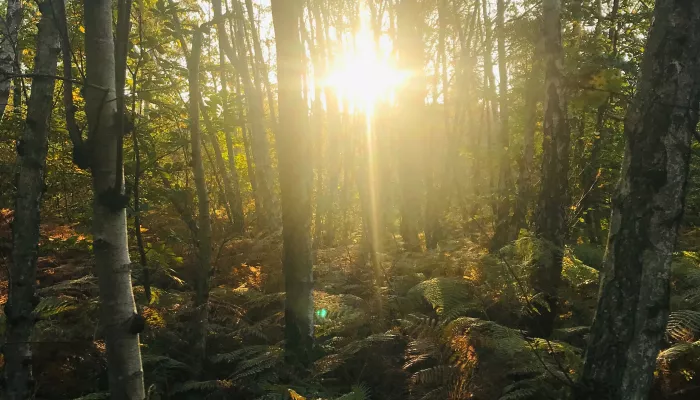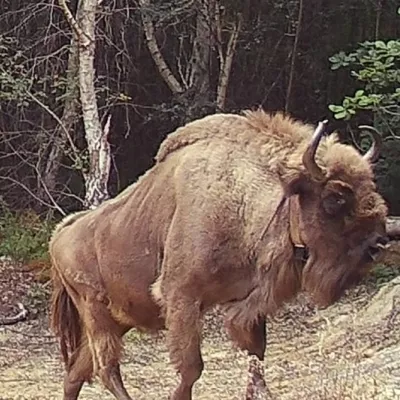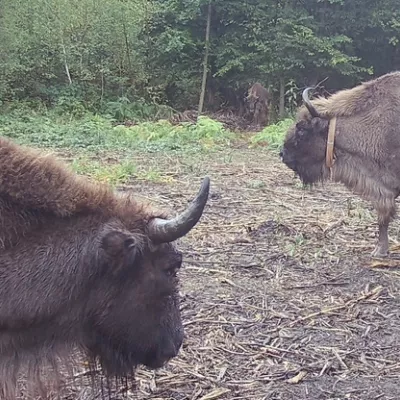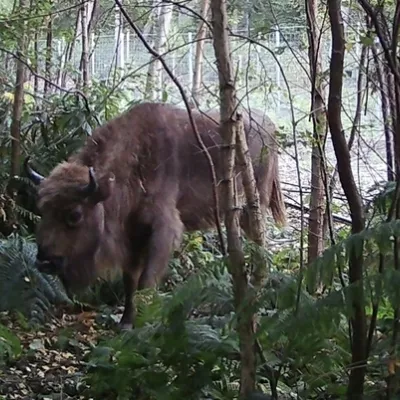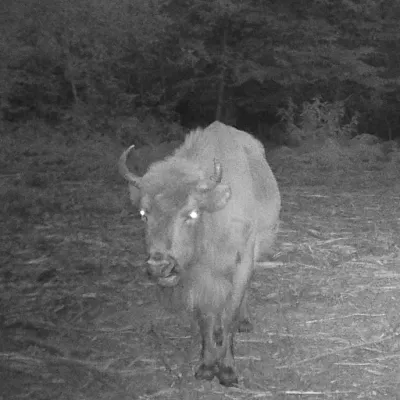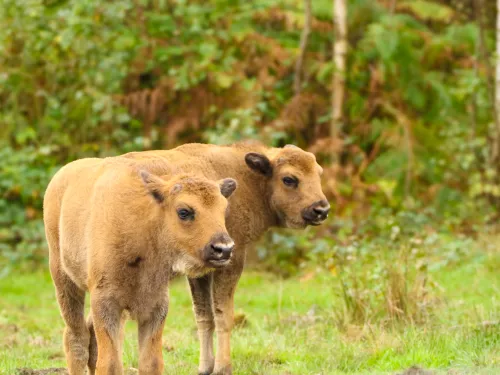

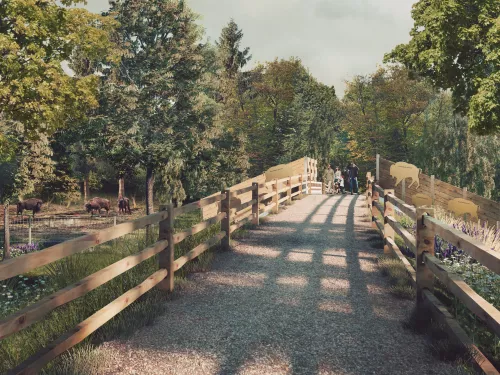
Work on bison bridges begins 23/9/24
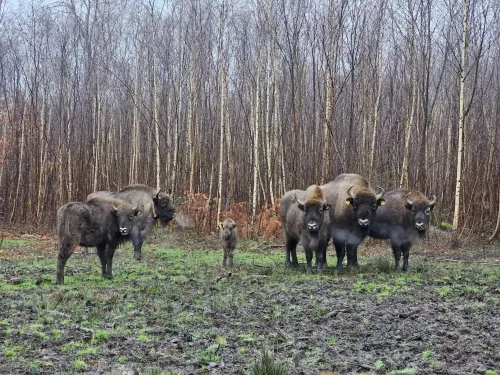
Wilder Blean two years on 18/07/24
Celebrating two years of bison in the Blean!
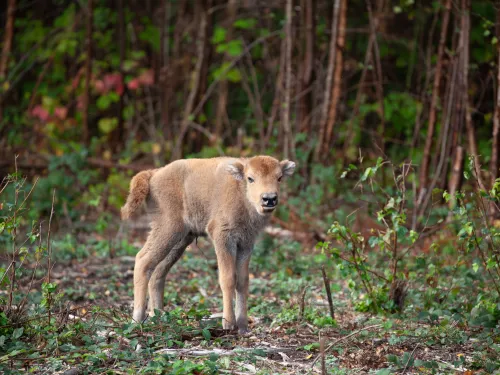
New baby bison Dec 2023
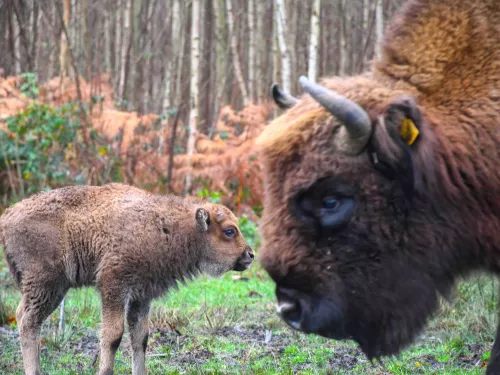
Blean Bison Project calf reaches her first birthday
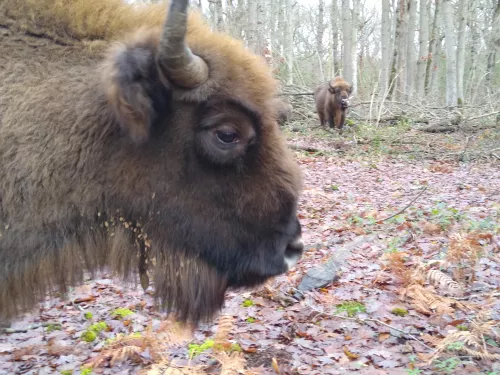
It's Blean a year already - charities celebrate one year of the Wilder Blean project
Where possible, please include a link to our project page.
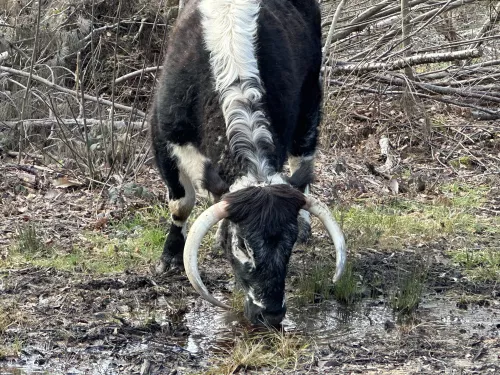
Wilder Blean Project seeks new Bison and Conservation Grazing Rangers 23/03/23
Where possible, please include a link to our Just Giving page.

Bison bridges - what are they? 17/03/23
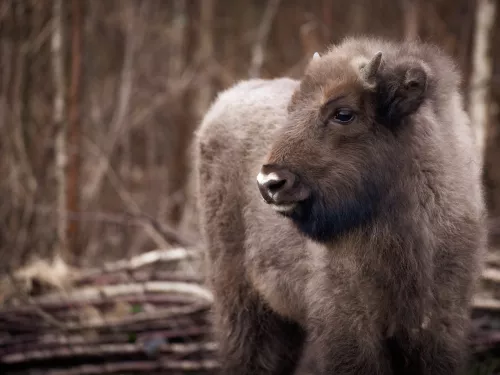
Bison calf reaches 6-months 22/2/23
Please include our Just Giving link within your story.
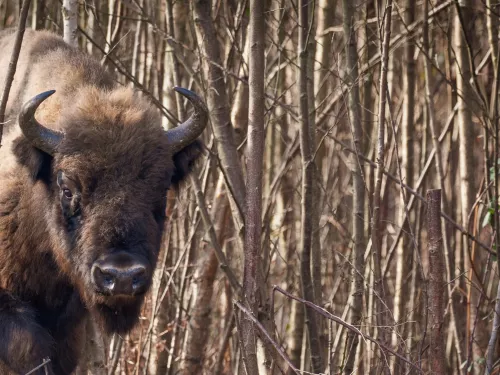
Bison bull released into Blean woods 24/12/22
Please click here. Please reference our Just Giving page in your story.

Bison released in wider woodland 22/11/22
We appreciate it if you include a link to our Just Giving page within your story.
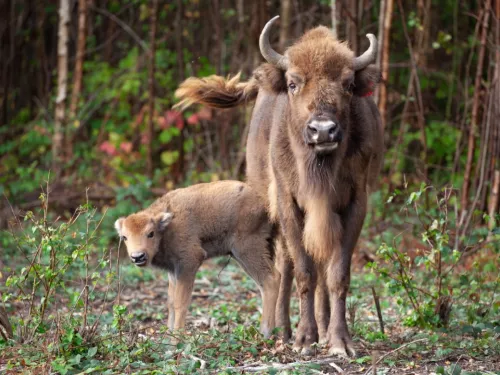
Blean just got wilder - baby bison born! 21/10/22
Please share out Just Giving Page if using footage and images.
Three go wild in Canterbury - an update on the Wilder Blean Project
- A month after three wild bison were released into West Blean and Thornden Woods, bison rangers Tom and Don say the trio are having a ‘remarkable impact’ on the landscape.
- The youngsters have been enjoying playing games of chase, debarking trees and eating everything in sight!
- The ecosystem engineers have adapted well, despite the hot weather, cooling down in the dense woodland.
- The bison will re-shape the landscape through their natural behaviours, helping to fight the climate and biodiversity crises.
- Bison ranger Don says the project is a ‘ray of hope’ in our efforts to save the planet.
A month after the UK’s first wild bison were released into West Blean and Thornden Woods, Bison Rangers Tom Gibbs and Donovan Wright give an insight into how the herd has settled. From games of chase amongst the youngsters to the matriarch’s unusual taste for bracken, living life on the wild side is what these three ecosystem engineers were born to do.
Bison Ranger Tom Gibbs explains: “Whilst they are very much wild animals, they have distinctive personalities. I have seen the two younger females playing and enjoying their surroundings. They will jump in the air when they get excited, chase each other and run around. They also have quite specific head movements when at play. They are really enjoying being outside, it’s fantastic they are comfortable enough to interact in this way.
“The herd is exploring more and more of the woodland. Initially they did not wander too far away from the corral - the area where they had their veterinary checks on their first day. As time has gone on, they are getting accustomed to the site and are venturing further each day.
“The matriarch likes the bracken and can often be seen trampling and even lying down on it. The calf with one horn seems to have a taste for brambles. It will be interesting to see her face once the berries start to come through. To grow, the berries need light, and the bison are beginning to create more light in the woodland already through their natural behaviours, so in a way they are making their own dessert!”
The bison have been released into the woodland as part of the Wilder Blean Project, a joint wilding initiative between Kent Wildlife Trust and Wildwood Trust. The bison will reshape the landscape, creating light and space for wildlife to thrive. It is hoped the project will be used as a template for other organisations to fight the climate and biodiversity crises.
Bison Ranger Donovan Wright explains how, in just one month, they are already changing the structure of the woodland: “The bison have already had a remarkable impact. I did not expect it to be so sudden, but literally from the first day you could sense their presence in the woods.
“We have seen them create a network of paths opening up trails of up to a meter wide. Through dense silver birch thickets that were once almost impenetrable, you can now comfortably walk along bison trails. And we are not the only ones using them, I have seen foxes, rabbits, and a slow worm sunbathing on one.
“When you follow the bison trails there is the unmistakable smell of bison in the air, and of course bison droppings. They have healthy appetites, eating up to 35kg of vegetation a day, and with that come lots of fertilizing and seed dispersal.
“The birds have figured out that bison droppings attract invertebrates. They have been pecking at the bison dung, feasting off insects.”
It took just over two years to get to a stage where the herd could be released into the Blean, with the global pandemic and Brexit causing delays to the importation process. Over that time Tom and Don eagerly awaited the arrival of the bison.
Don explains the impact the animals have made on him: “It is great we are fully fledged Bison Rangers now. I pinch myself every day. It is such a privilege to spend time with the bison and to witness the changes taking place in the woods. Every day I am awestruck. Everybody should have this experience.
“I am overwhelmed with gratitude for the bison and the privilege of spending time with them, as well as the Wilder Blean vision and all that has gone in to make it a reality.
“I also feel the weight of responsibility, not only for taking care of the bison, but also for helping people reconnect with nature. This is just the start, and hopefully a ray of hope in our efforts to save our planet.”
The arrival of the three female bison is the first milestone within the Wilder Blean Project. Within the next eight weeks a bull from Germany will be released into the herd and it is hoped within time that they will breed. Once the herd are settled, Longhorn cattle, Iron-Age pigs and Exmoor ponies will also be released into the Blean. Each animal has its own unique impact on the woodland to help nature thrive.
West Blean and Thornden Woods will be closely monitored by experts who will be surveying wildlife abundance, new species that make the woods home and even measure the carbon that will be captured within the woodland.
The project became a reality thanks to funding from Players of People’s Postcode Lottery who provided £1.125m from the Annual Dream Fund.
Can you help our vision for a Wilder Blean?
Donations are welcomed from those who want to create a Wilder Blean for the future.
-ends-
New photos of the bison updated 18/0822
Strictly under embargo until 6am on Monday 18th July 2022
BISON RELEASED INTO THE WILD TO TACKLE CLIMATE CHANGE AS UK TEMPERATURES SOAR
As experts predict the hottest day of the year – two leading conservation charities release bison into the wild to help tackle the climate crisis.
- A ground-breaking project to slow the climate crisis using wild bison has reached a major milestone on what is predicted to be the hottest day on record this year.
- The Met Office has issued an amber weather warning with temperatures potentially reaching 35C – with Britons set to endure the very real effects of the climate crisis.
- In the cooler part of the day, shortly before 7am, European bison were released into West Blean and Thornden Woods, Kent.
- The bison are ‘eco-system engineers’ which means they will restore life to the woodland through their natural behaviours and offer a nature-based solution to tackle the climate and biodiversity crises.
- This is the first-time bison have roamed in the UK for thousands of years.
- The historic event occurs two years into a five-year project by the wildlife charities Kent Wildlife Trust and Wildwood Trust, funded by players of People’s Postcode Lottery.
A pioneering conservation project reached a historic milestone as European bison were released into an ancient woodland in Kent on what is predicted to be the hottest day of the year so far, Monday 18th July 2022.
The bison will create a more climate resilient landscape within West Blean and Thorden Woods, near Canterbury, Kent, and their natural behaviours will help restore dynamic and complex habitats.
By creating layers within the forest and naturally felling trees, the woodland will move away from being a monoculture, and wetter areas will not only store carbon, but reduce flood risk.
This is the first time in thousands of years that wild bison have roamed in UK woodlands as part of a landmark experiment to test this nature-based solution to habitat management as well as combatting the climate and nature crises.
Evan Bowen-Jones Chief Executive Officer at Kent Wildlife Trust
Evan Bowen-Jones Chief Executive Officer at Kent Wildlife Trust said: “The restoration of naturally functioning ecosystems is a vital and inexpensive tool in tackling the climate crisis.
“The bison will help to create climate resistant landscapes which can adapt to the challenges presented by the crisis we face.
“We want Wilder Blean to mark the beginning of a new era for conservation in the UK. We need to revolutionise the way we restore natural landscapes, relying less on human intervention and more on natural engineers like bison, boar and beaver.
“Equally important, is that the Wilder Blean project will connect people with nature in a way that hasn't been possible before in the UK because we haven't had big wild animals present in our landscapes. We hope that those who visit the woodland and learn about the project will be inspired by what we are doing and become champions for nature too.”
European bison are a keystone species who will help restore natural processes in West Blean and Thornden Woods. Known as ‘eco-system engineers,’ the bison will breathe new life into the ancient woodland. Their natural behaviours such as grazing, eating bark, felling trees and taking dust baths will open the canopy, creating light and new spaces for wildlife and previously missing species to thrive.
The bison will soon be joined by other grazing animals, including Exmoor ponies, Iron Age pigs and Longhorn cattle, whose natural behaviours compliment the bison and will help to manage the landscape without the need for human intervention. Their impact on biodiversity and the landscape will be closely monitored in a long-term survey programme led by Kent Wildlife Trust.
Paul Whitfield, Director General of Wildwood Trust
Paul Whitfield Director General of Wildwood Trust said: “Today heralds a new dawn for conservation and the fight against climate change.
"As well as helping the biodiversity crisis, one of the fantastic things about this ground-breaking project is that it’s going to demonstrate the very real impact nature based solutions can have in solving the climate crisis. The two are intrinsically linked and we can’t solve one without the other.
"With this project, we’re going to prove the impact bison in the wild can have on the environment. They will create an explosion of biodiversity and build habitat resilience; locking in carbon to help reduce global temperature rise. This will act as a huge catalyst for change, with the project being replicated on scale across the country.. It will make a phenomenal difference. Its great news in these worrying times.
“Not only this but we're giving people in the UK - for the first time in over a thousand years - the chance to experience bison in the wild. It's a really powerful emotional, visceral experience and it’s something we’ve lost in this country. It's an absolute privilege to be part of the team that's bringing that back.”
James Seymour, Natural England’s Area Manager for Sussex and Kent, said:
“We welcome the Kent Wildlife Trust’s plans to restore West Blean and Thornden Woods SSSI, and compare the benefits of different habitat management approaches, including the use of bison. We want to support projects that aid nature recovery and connect communities with their natural environment.”
This £1.125m project was funded by money raised by players of People’s Postcode Lottery and awarded through the annual Dream Fund.
Laura Chow, head of charities at People’s Postcode Lottery, said: “The introduction of these extraordinary animals to British woodlands is a significant moment in the fight to protect and enhance biodiversity. It’s fantastic to see support from players of People’s Postcode Lottery going towards restoring and increasing biodiversity and bio-abundance in West Blean woods.”
The Wilder Blean project was created as a direct response to the decline in natural species in the UK, which, according to the State of Nature Report, has seen species decline at the fastest rate in thousands of years. Introducing bison is also an alternative to traditional human woodland management, giving nature the tools and space it needs to recover.
-ends-
Animal welfare has been at the heart of this project, with the wellbeing of the bison taking precedence over any media activity.
For more information please contact [email protected]
More background on the project can be found on our website: /wilderblean
Monitoring: The impact of the animals on the landscape will be part of an ecological monitoring programme led by Kent Wildlife Trust. This includes monitoring multiple ecological parameters to detect changes over time. Everything from soil sampling and worm counts to collecting data on vegetation structure will be examined. The team will also be monitoring several different groups of species including, invertebrates, birds and mammals. Read more about the Wilder Blean monitoring programme here.
State of nature in Kent Report: Our wildlife and environment is under threat from hotter summers, but nature also has some of the answers to climate change. This is one of the many findings of “The State of Nature in Kent” report, just published. The Kent Nature Partnership (KNP) – a group of organisations standing up for nature in Kent and Medway – commissioned the report, which was compiled by Kent Wildlife Trust. Read the full report here.
More about bison: European bison (Wisent) were almost extinct in the wild at the end of the Second World War. Since then they have recovered but still remain an endangered species. Several pioneering projects in Europe, including in the Netherlands have seen these animals return from the brink and demonstrated the incredible impacts they can have on species diversity and abundance. The Blean bison will form part of the European Endangered Species Protection Programme and this project will be a pioneering first for UK Conservation.
Kent Wildlife Trust, Wildwood Trust and People's Postcode Lottery
Click here for videos of:
Camera trap footage of the release
Camera trap footage of the release #2
Drone footage of The Blean - kindly note this was taken prior to the bison arriving. Drones cannot be used around the bison.
Postcode Lottery Dream Fund announcement - why this project is so important.
Paul Hadaway, Director of Conservation at Kent Wildlife Trust discusses wilding.
Mark Habben, Wildwood Trust talks about Brexit and the bison.
Paul Hadaway, Director of Conservation at Kent Wildlife Trust talks about the arrival.
Aiden Rafferty Hoofstock, talks about our bison from Ireland and the Wilder Blean Project.
Read more about the Wilder Blean Team and what the project means to them.
Evan Bowen-Jones, Chief Executive
Evan Bowen-Jones Chief Executive Officer at Kent Wildlife Trust said: “The restoration of naturally functioning ecosystems is a vital and inexpensive tool in tackling the climate crisis.
“The bison will help to create climate resistant landscapes which can adapt to the challenges presented by the crisis we face.
“We want Wilder Blean to mark the beginning of a new era for conservation in the UK. We need to revolutionise the way we restore natural landscapes, relying less on human intervention and more on natural engineers like bison, boar and beaver.
“Equally important, is that the Wilder Blean project will connect people with nature in a way that hasn't been possible before in the UK because we haven't had big wild animals present in our landscapes. We hope that those who visit the woodland and learn about the project will be inspired by what we are doing and become champions for nature too.”
Wildwood Trust, Director General, Paul Whitfield
Wildwood Trust, Director General, Paul Whitfield: “I have wanted to see bison in the woodlands of Kent for over ten years and after three years of challenges and determined focused work we have been able to make it happen. This is a huge step forward for species recovery in the UK and will open the door for many more important wilding projects in the future.
“It’s a huge achievement and I am incredibly proud of the team that they have been able to realise that dream.”
Paul Hadaway, Director of Conservation
Kent Wildlife Trust, Director of Conservation, Paul Hadaway: "Wilder Blean is symbolic of the journey travelled by UK conservation and for me reflects the scale, ambition and new thinking required to change the world we find ourselves in. Having spent nearly 30yrs working in conservation, from a volunteer to where I am now, I have to question the impact I’ve had in that time.
"We are in the midst of a climate and nature crises, restoration of functions ecosystems at a landscape scale has never been more vital and organisation like KWT never more relevant. "To achieve that we have to understand that ‘traditional’ prescriptive conservation management is not the answer, it’s no longer enough to protect small areas of land, we need to restore nature and natural processes at scale and we have to do it now.
"Bringing bison to an English woodland will always raise strong opinions but the impact they will have can not be underestimated and the interest, excitement, and sometimes controversy they create is vital to driving new, innovative action – if we can create diverse, dynamic, bio-abundant habitats in our crowded corner of the South East why shouldn’t we be doing it in our National Parks and protected landscapes. "I’m immensely proud of our team and to be part of such a game-changing initiative as the Wilder Blean."
Kent Wildlife Trust, Wilding Evidence Ecologist, Kora Kunzmann
"The monitoring programme is extensive, we have three treatment areas, and we are taking an experimental approach.
"The first treatment area sees bison grazing alongside Exmoor ponies and iron age pigs, the second contains the long-horn cattle with the pigs and ponies and the third is our control zone which will contain no grazing animals.
"Not only will we be able to see changes happening over time, we will also see the changes between the bison and long-horn cattle, the exact difference the bison are making and compare it to an area with no grazing animals.
"Bison have a unique ecology like no other animal. They create standing deadwood through their natural behaviour and this creates space for invertebrates, brings light to the forest floor and encourages native species to grow.
"The standing deadwood will increase the invertebrate abundance and invertebrate diversity which in turn will increase the bird abundance and diversity.
"Another unique behaviour of the bison is to roll around in a sand pit, creating a dust bath which is valuable for burrowing insects and invertebrates.
"We hope that Wilder Blean will be a trial run for projects like this across the UK, so people can see that bison can be the nature-based solution in order to restore our woodlands."
Kent Wildlife Trust, Wilder Kent Education and Engagement Officer, Elysia Davies
Kent Wildlife Trust, Wilder Kent Education and Engagement Officer, Elysia Davies: 'To me the Wilder Blean project is about making a radical change in how we think about nature. To start looking after nature in its full complexity, and letting wildlife take the lead. The Wilder Blean project is about proving that we can have wild spaces full of nature embedded within the densely populated south east of England. Spaces where people and wildlife share the space and co-exist. "The Wilder Blean project is ambitious and provides hope that we have the tools, motivation and community buy-in to fight the climate and biodiversity crises locally and beyond."
Donovan Wright - Bison Ranger
Donovan Wright, Bison Ranger: "The European bison will be free roaming and managing the woods in a natural, sustainable way. There will be minimal human intervention allowing the bison to display natural behaviours. They are ecosystem engineers and have the wonderful ability to restore natural processes, increase biodiversity, increase bio abundance, promote natural regeneration, restore habitats and improve resilience within the ecosystem. There are bison in other UK wildlife parks but they are contained in smaller areas and receive supplementary feeding.
"To have free roaming European bison 5 miles from Canterbury is a step in the right direction. A step to towards larger, healthier, more interconnected wild spaces. A vison of a future where we can live in harmony with nature.
"This is a wonderful opportunity to reconnect with nature. I can’t wait to see people, of all ages, out and about enjoying the wonders of nature. Families, school groups, students, dog walkers, runners and cyclists… people passionate about flowers, birds, trees and fungi… people pursuing interests in photography and wellbeing… they are all welcome.
"I can’t wait to track the bison through the woods, to see the first bison calf born in the Blean, and to witness the transformative changes they will bring to the Blean."
Wildwood Trust, Conservation Officer, Vicki Breakell
Wildwood Trust, Conservation Officer, Vicki Breakell: "The arrival of the bison to the Blean is an accomplishment of like-minded people and organisations coming together for nature! Not only will this project help tackle the climate and biodiversity crisis but also supports the long standing conservation breeding programme to save the species.
“I’m excited by the opportunities to learn more about this magnificent mammal and to showcase their amazing work as an ecosystem engineer.”
Tom Gibbs - Bison Ranger
Topm Gibbs - Bison Ranger: "Seeing the Bison amidst the habitats of the Blean really feels like an iconic moment in how we approach land management here in the UK. It evokes a sense of wildness that in many ways feels alien to us here as it’s been such a long time since we had large, wild, free-roaming herbivores and feels especially poignant in this corner of Kent where so many people live. To me, it feels like we are joining two ends of a rope – connecting our wilder, ancestral landscapes where large grazing animals once roamed freely, along with our wilder future where people and wild animals coexist, side by side once again.
"It’s so exciting to be part of a project thinking about land management on a macro-scale and timeline and I cannot wait to see how the Bison start to shape the Blean over a 5, 10, 20 year period as they settle into their new home and start throwing their weight around! The impacts they are going to have through dustbathing, to debarking trees even down to their dung, is going to benefit a myriad of other species and help them to adapt, especially in a time of uncertainty for nature. It’s fascinating to think of how the lines between the managed, non-native parts of the wood, will mingle and blur with the natural woodland and other habitats as natural processes are restored and is going to act as an amazing beacon for other parts of the UK who want to do something similar!"
Wildwood Trust, Director of Conservation, Laura Gardner
Wildwood Trust, Director of Conservation, Laura Gardner: “In order to tackle the alarming loss of our wildlife and mitigate the effects of the climate crisis, we need to challenge and change traditional approaches to conservation.
“This project aims to give nature the space to heal herself, using the bison to restore complexity within the Blean woods and increasing the biodiversity of wildlife within it. What is equally crucial is the detailed monitoring that is embedded in the project; this ensures that this and future conservation is robust and evidence led.
“We know how connection to nature benefits not only our health and well- being but nature is our life support system, we can only survive if nature thrives.”
Kent Wildlife Trust, Head of Wilder People and Places, Keeley Atkinson
Kent Wildlife Trust, Head of Wilder People and Places, Keeley Atkinson: "This is such an innovative and exciting project, so many people are really worried about the climate and nature crisis but not sure what they can do about it. To be able to demonstrate, through the introduction of these amazing ecosystem engineers into the woodland, we can demonstrate how their natural behaviour will restore natural processes to the woodland, this benefits so many other species and improves the whole ecosystem. "This project has generated so much interest, locally and nationally and we are delighted that the local community have generally embraced it and are exciting at the prospect of having a ground breaking project right on their door step. "I’m constantly amazed and impressed by the passion, enthusiasm and hard work of the team and I am so proud to be part of it."
Wildwood Trust, Director of Zoological Operations, Mark Habben
Wildwood Trust, Director of Zoological Operations, Mark Habben: “The Wilder Blean Project is about restoring landscape using large grazing herbivores to do the kind of jobs that machinery would usually do.
“Out in the Blean there are a lot of non-native trees, as well as large monocultures of species like birch. The idea behind the project is to restore the area using the bison. They are a heavy animal, they’ll push through bushes and trees and in doing so they’ll open up a more biodiverse habitat for a range of different species.”
The Wilder Blean monitoring project
For more information on the Blean monitoring project click here.
Bison tracking by Smart Parks
Smart Parks is a Dutch non-profit organisation with the mission to protect endangered wildlife species across the globe with advanced technology.
Last February the Smart Parks team travelled to Kent to build the first Smart Parks system in the UK. The system creates LoRaWAN® coverage in the Blean Woods, making it possible to track the movement of the bisons. WisentEdge collars, which are power efficient GPS-LoRaWAN® devices, are placed on the animals. With lower power consumption than traditional GPS collars, and thus longer battery life, these sensors are especially suitable for tracking wildlife for multiple years by minimizing intervention and disturbance.
The near real-time updates will support the first-ever bison rangers with their important task to look after and manage UK’s first conservation herd. Smart Parks is involved in different rewilding projects that include the reintroduction of bison, in e.g., Zuid-Kennemerland and National Park the Veluwe.

